Leadership and Operations Management Report: Starbucks Case Study
VerifiedAdded on 2023/01/06
|12
|3133
|53
Report
AI Summary
This report provides a comprehensive analysis of leadership and operations management, using Starbucks as a case study. It begins with an introduction to management and operations, emphasizing their roles in organizational success. The report then delves into the different leadership theories, including situational, systems, and contingency leadership, and their application within Starbucks. It assesses the strengths and weaknesses of these approaches and critically evaluates their impact on decision-making. The report further explores key approaches to operations management, such as total quality management, lean manufacturing, and Six Sigma, and their importance in achieving business objectives. It evaluates how leaders and managers can improve operational efficiencies to meet these objectives. Finally, the report examines the factors within the business environment, including political, economic, social, technological, and environmental factors (PESTEL analysis), that impact operational management and decision-making. The report concludes with a critical evaluation of the application of operations management and the factors that impact the wider business environment.
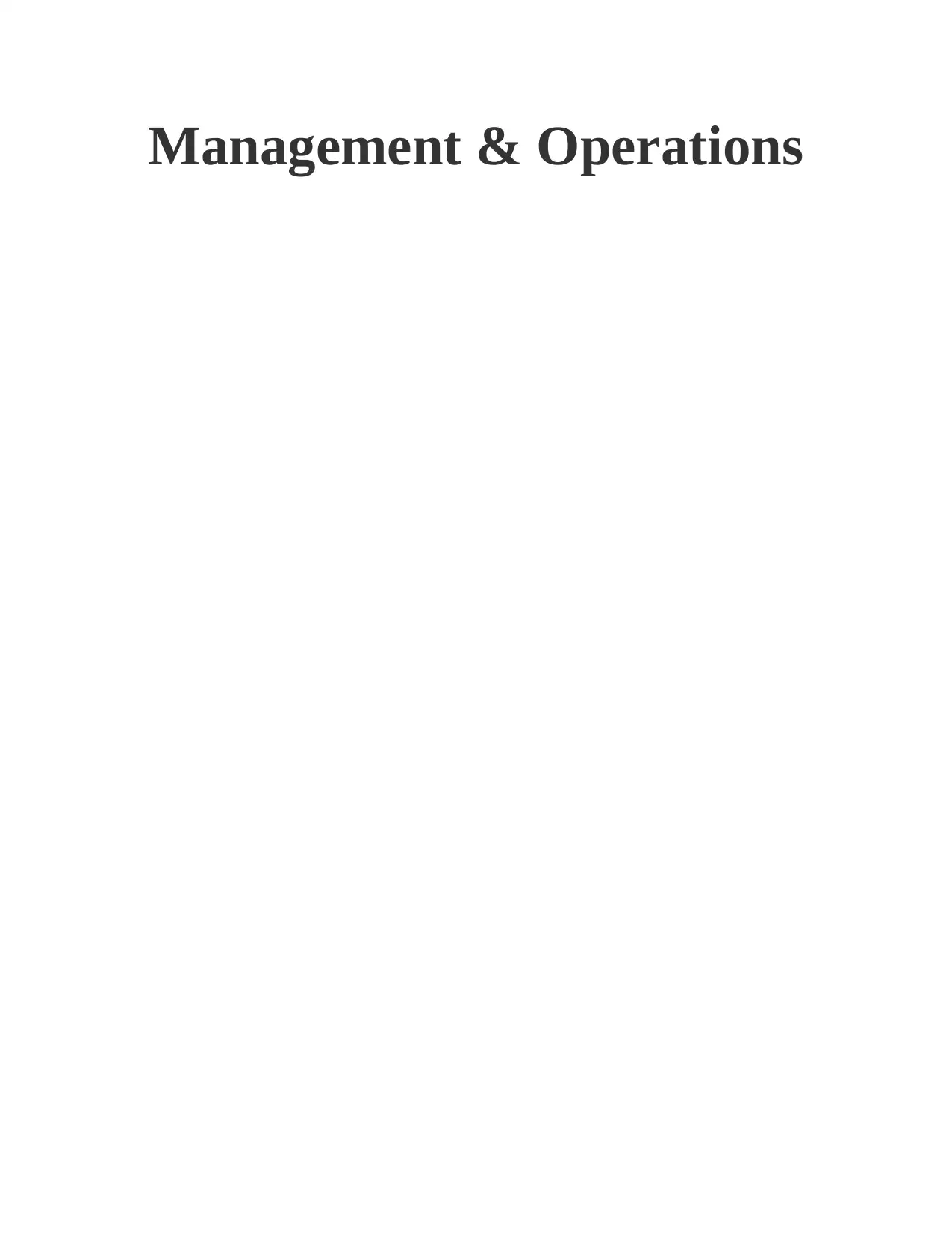
Management & Operations
Paraphrase This Document
Need a fresh take? Get an instant paraphrase of this document with our AI Paraphraser
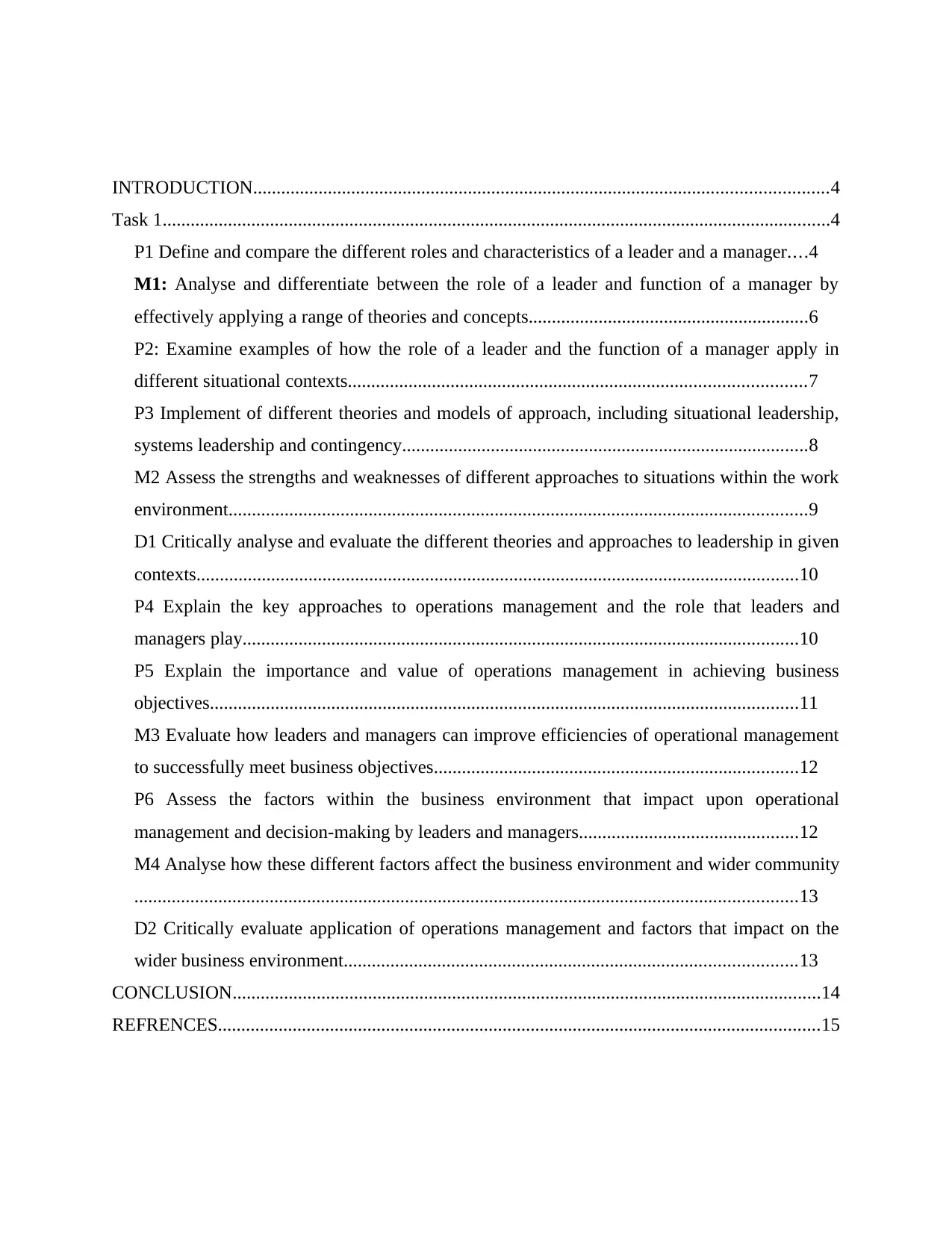
INTRODUCTION...........................................................................................................................4
Task 1...............................................................................................................................................4
P1 Define and compare the different roles and characteristics of a leader and a manager....4
M1: Analyse and differentiate between the role of a leader and function of a manager by
effectively applying a range of theories and concepts............................................................6
P2: Examine examples of how the role of a leader and the function of a manager apply in
different situational contexts..................................................................................................7
P3 Implement of different theories and models of approach, including situational leadership,
systems leadership and contingency.......................................................................................8
M2 Assess the strengths and weaknesses of different approaches to situations within the work
environment............................................................................................................................9
D1 Critically analyse and evaluate the different theories and approaches to leadership in given
contexts.................................................................................................................................10
P4 Explain the key approaches to operations management and the role that leaders and
managers play.......................................................................................................................10
P5 Explain the importance and value of operations management in achieving business
objectives..............................................................................................................................11
M3 Evaluate how leaders and managers can improve efficiencies of operational management
to successfully meet business objectives..............................................................................12
P6 Assess the factors within the business environment that impact upon operational
management and decision-making by leaders and managers...............................................12
M4 Analyse how these different factors affect the business environment and wider community
..............................................................................................................................................13
D2 Critically evaluate application of operations management and factors that impact on the
wider business environment.................................................................................................13
CONCLUSION..............................................................................................................................14
REFRENCES.................................................................................................................................15
Task 1...............................................................................................................................................4
P1 Define and compare the different roles and characteristics of a leader and a manager....4
M1: Analyse and differentiate between the role of a leader and function of a manager by
effectively applying a range of theories and concepts............................................................6
P2: Examine examples of how the role of a leader and the function of a manager apply in
different situational contexts..................................................................................................7
P3 Implement of different theories and models of approach, including situational leadership,
systems leadership and contingency.......................................................................................8
M2 Assess the strengths and weaknesses of different approaches to situations within the work
environment............................................................................................................................9
D1 Critically analyse and evaluate the different theories and approaches to leadership in given
contexts.................................................................................................................................10
P4 Explain the key approaches to operations management and the role that leaders and
managers play.......................................................................................................................10
P5 Explain the importance and value of operations management in achieving business
objectives..............................................................................................................................11
M3 Evaluate how leaders and managers can improve efficiencies of operational management
to successfully meet business objectives..............................................................................12
P6 Assess the factors within the business environment that impact upon operational
management and decision-making by leaders and managers...............................................12
M4 Analyse how these different factors affect the business environment and wider community
..............................................................................................................................................13
D2 Critically evaluate application of operations management and factors that impact on the
wider business environment.................................................................................................13
CONCLUSION..............................................................................................................................14
REFRENCES.................................................................................................................................15

⊘ This is a preview!⊘
Do you want full access?
Subscribe today to unlock all pages.

Trusted by 1+ million students worldwide

INTRODUCTION
Management is the process by which an organization manages its process that has been
helping an organizations to achieve goals and objectives set by an organization. Management of
an organization is done by planning, organizing, staffing, leading or directing, and monitoring
activities. Operations are those activities that has to be performed by employees working in an
organization. Both management and operations has an important role in making an organization
gain growth and success. Scope of management and operations is wider as they deal with overall
development of an organization. Nature is dynamic as they cover lot of aspects related to
working of organization also. Organization that has been taken is Starbucks multinational chain
of coffee houses situated in Seattle, Washington. Things to be covered in file role of a leader and
function of a manager, key approaches to operations management and various other things,
environmental factors. In the end factors affect the business environment has to be explained.
Task 1
Coverd in ppt
P3 Implement of different theories and models of approach, including situational leadership,
systems leadership and contingency
Leadership theory plays an important role for an organisation specifically for Marks &
Spencer because they are performing operations and functions of company at a global level.
There are different theories is mention that include role of leader and manager of an organisation
(Lee and Tang, 2018).
Situational leadership- According to the methods of situational leadership style it is
identified that there is no particular style of leadership. It refers that leaders adopt the mode of
leadership according to specific situation or problem. Moreover, there are different
circumstances relates with leadership style so to solve the issue in minimum time period.
STARBUCS leaders is focused to work according to situation of leadership. This also improve
working style because situational leadership theory provide direction to workforce for
Management is the process by which an organization manages its process that has been
helping an organizations to achieve goals and objectives set by an organization. Management of
an organization is done by planning, organizing, staffing, leading or directing, and monitoring
activities. Operations are those activities that has to be performed by employees working in an
organization. Both management and operations has an important role in making an organization
gain growth and success. Scope of management and operations is wider as they deal with overall
development of an organization. Nature is dynamic as they cover lot of aspects related to
working of organization also. Organization that has been taken is Starbucks multinational chain
of coffee houses situated in Seattle, Washington. Things to be covered in file role of a leader and
function of a manager, key approaches to operations management and various other things,
environmental factors. In the end factors affect the business environment has to be explained.
Task 1
Coverd in ppt
P3 Implement of different theories and models of approach, including situational leadership,
systems leadership and contingency
Leadership theory plays an important role for an organisation specifically for Marks &
Spencer because they are performing operations and functions of company at a global level.
There are different theories is mention that include role of leader and manager of an organisation
(Lee and Tang, 2018).
Situational leadership- According to the methods of situational leadership style it is
identified that there is no particular style of leadership. It refers that leaders adopt the mode of
leadership according to specific situation or problem. Moreover, there are different
circumstances relates with leadership style so to solve the issue in minimum time period.
STARBUCS leaders is focused to work according to situation of leadership. This also improve
working style because situational leadership theory provide direction to workforce for
Paraphrase This Document
Need a fresh take? Get an instant paraphrase of this document with our AI Paraphraser
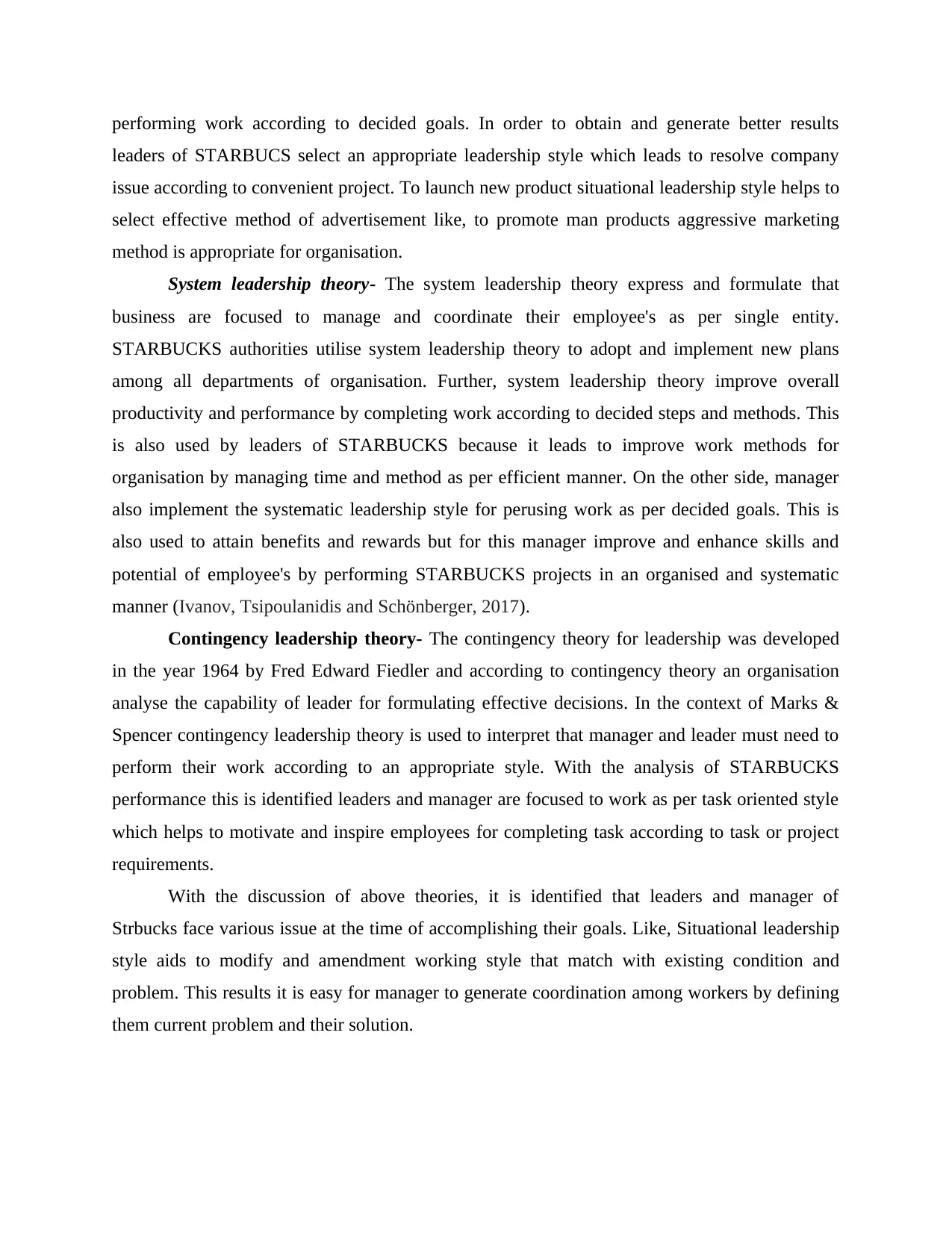
performing work according to decided goals. In order to obtain and generate better results
leaders of STARBUCS select an appropriate leadership style which leads to resolve company
issue according to convenient project. To launch new product situational leadership style helps to
select effective method of advertisement like, to promote man products aggressive marketing
method is appropriate for organisation.
System leadership theory- The system leadership theory express and formulate that
business are focused to manage and coordinate their employee's as per single entity.
STARBUCKS authorities utilise system leadership theory to adopt and implement new plans
among all departments of organisation. Further, system leadership theory improve overall
productivity and performance by completing work according to decided steps and methods. This
is also used by leaders of STARBUCKS because it leads to improve work methods for
organisation by managing time and method as per efficient manner. On the other side, manager
also implement the systematic leadership style for perusing work as per decided goals. This is
also used to attain benefits and rewards but for this manager improve and enhance skills and
potential of employee's by performing STARBUCKS projects in an organised and systematic
manner (Ivanov, Tsipoulanidis and Schönberger, 2017).
Contingency leadership theory- The contingency theory for leadership was developed
in the year 1964 by Fred Edward Fiedler and according to contingency theory an organisation
analyse the capability of leader for formulating effective decisions. In the context of Marks &
Spencer contingency leadership theory is used to interpret that manager and leader must need to
perform their work according to an appropriate style. With the analysis of STARBUCKS
performance this is identified leaders and manager are focused to work as per task oriented style
which helps to motivate and inspire employees for completing task according to task or project
requirements.
With the discussion of above theories, it is identified that leaders and manager of
Strbucks face various issue at the time of accomplishing their goals. Like, Situational leadership
style aids to modify and amendment working style that match with existing condition and
problem. This results it is easy for manager to generate coordination among workers by defining
them current problem and their solution.
leaders of STARBUCS select an appropriate leadership style which leads to resolve company
issue according to convenient project. To launch new product situational leadership style helps to
select effective method of advertisement like, to promote man products aggressive marketing
method is appropriate for organisation.
System leadership theory- The system leadership theory express and formulate that
business are focused to manage and coordinate their employee's as per single entity.
STARBUCKS authorities utilise system leadership theory to adopt and implement new plans
among all departments of organisation. Further, system leadership theory improve overall
productivity and performance by completing work according to decided steps and methods. This
is also used by leaders of STARBUCKS because it leads to improve work methods for
organisation by managing time and method as per efficient manner. On the other side, manager
also implement the systematic leadership style for perusing work as per decided goals. This is
also used to attain benefits and rewards but for this manager improve and enhance skills and
potential of employee's by performing STARBUCKS projects in an organised and systematic
manner (Ivanov, Tsipoulanidis and Schönberger, 2017).
Contingency leadership theory- The contingency theory for leadership was developed
in the year 1964 by Fred Edward Fiedler and according to contingency theory an organisation
analyse the capability of leader for formulating effective decisions. In the context of Marks &
Spencer contingency leadership theory is used to interpret that manager and leader must need to
perform their work according to an appropriate style. With the analysis of STARBUCKS
performance this is identified leaders and manager are focused to work as per task oriented style
which helps to motivate and inspire employees for completing task according to task or project
requirements.
With the discussion of above theories, it is identified that leaders and manager of
Strbucks face various issue at the time of accomplishing their goals. Like, Situational leadership
style aids to modify and amendment working style that match with existing condition and
problem. This results it is easy for manager to generate coordination among workers by defining
them current problem and their solution.
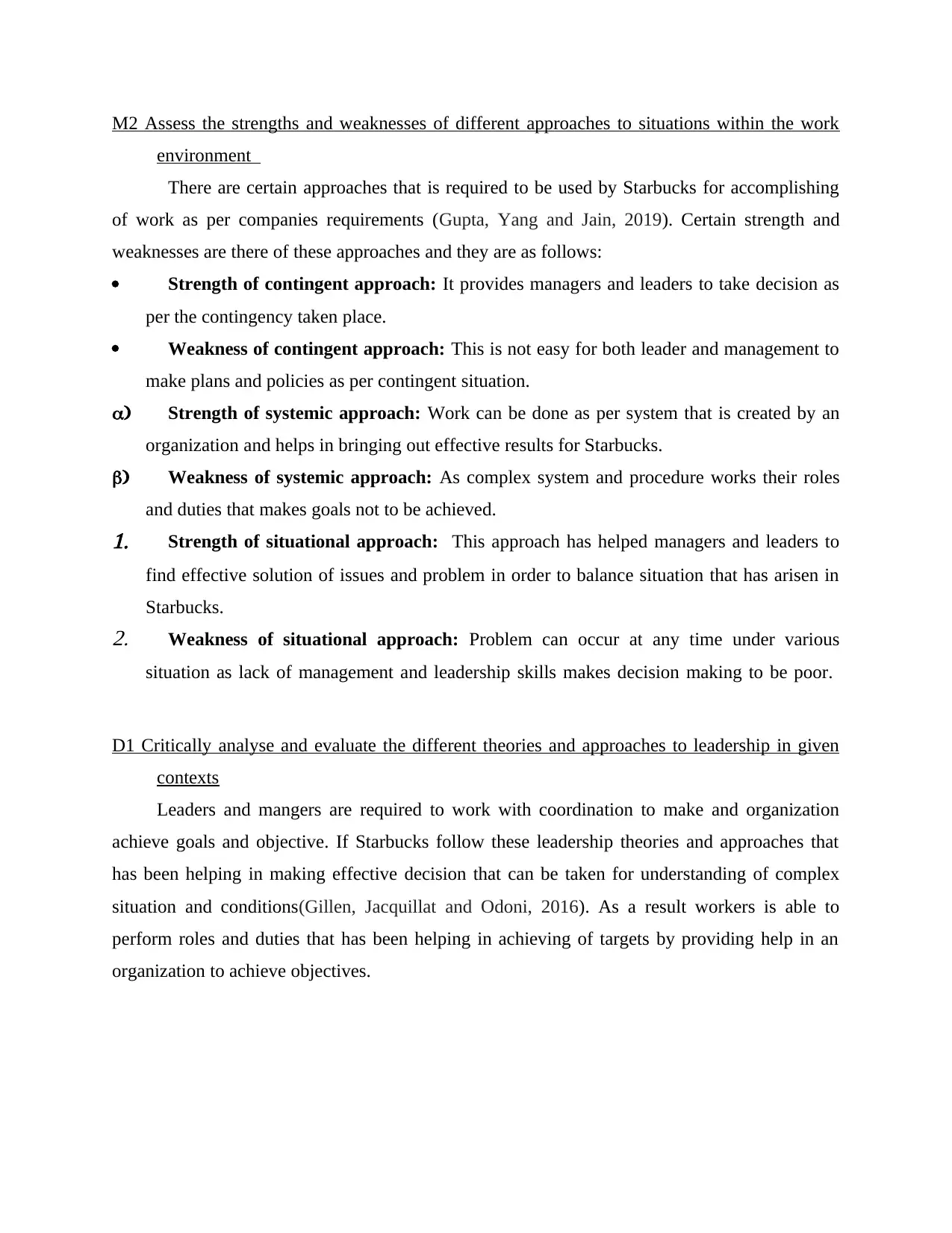
M2 Assess the strengths and weaknesses of different approaches to situations within the work
environment
There are certain approaches that is required to be used by Starbucks for accomplishing
of work as per companies requirements (Gupta, Yang and Jain, 2019). Certain strength and
weaknesses are there of these approaches and they are as follows:
Strength of contingent approach: It provides managers and leaders to take decision as
per the contingency taken place.
Weakness of contingent approach: This is not easy for both leader and management to
make plans and policies as per contingent situation.
a) Strength of systemic approach: Work can be done as per system that is created by an
organization and helps in bringing out effective results for Starbucks.
b) Weakness of systemic approach: As complex system and procedure works their roles
and duties that makes goals not to be achieved.1. Strength of situational approach: This approach has helped managers and leaders to
find effective solution of issues and problem in order to balance situation that has arisen in
Starbucks.2. Weakness of situational approach: Problem can occur at any time under various
situation as lack of management and leadership skills makes decision making to be poor.
D1 Critically analyse and evaluate the different theories and approaches to leadership in given
contexts
Leaders and mangers are required to work with coordination to make and organization
achieve goals and objective. If Starbucks follow these leadership theories and approaches that
has been helping in making effective decision that can be taken for understanding of complex
situation and conditions(Gillen, Jacquillat and Odoni, 2016). As a result workers is able to
perform roles and duties that has been helping in achieving of targets by providing help in an
organization to achieve objectives.
environment
There are certain approaches that is required to be used by Starbucks for accomplishing
of work as per companies requirements (Gupta, Yang and Jain, 2019). Certain strength and
weaknesses are there of these approaches and they are as follows:
Strength of contingent approach: It provides managers and leaders to take decision as
per the contingency taken place.
Weakness of contingent approach: This is not easy for both leader and management to
make plans and policies as per contingent situation.
a) Strength of systemic approach: Work can be done as per system that is created by an
organization and helps in bringing out effective results for Starbucks.
b) Weakness of systemic approach: As complex system and procedure works their roles
and duties that makes goals not to be achieved.1. Strength of situational approach: This approach has helped managers and leaders to
find effective solution of issues and problem in order to balance situation that has arisen in
Starbucks.2. Weakness of situational approach: Problem can occur at any time under various
situation as lack of management and leadership skills makes decision making to be poor.
D1 Critically analyse and evaluate the different theories and approaches to leadership in given
contexts
Leaders and mangers are required to work with coordination to make and organization
achieve goals and objective. If Starbucks follow these leadership theories and approaches that
has been helping in making effective decision that can be taken for understanding of complex
situation and conditions(Gillen, Jacquillat and Odoni, 2016). As a result workers is able to
perform roles and duties that has been helping in achieving of targets by providing help in an
organization to achieve objectives.
⊘ This is a preview!⊘
Do you want full access?
Subscribe today to unlock all pages.

Trusted by 1+ million students worldwide

P4 Explain the key approaches to operations management and the role that leaders and managers
play
Different key approaches of operations are there that has been supporting operations
management as it results into making all members perform roles according to necessary and
value of organization.
Total quality management: According to this approach has to be maintained and quality
is essential for an organization. Managers of Starbucks has set quality standards that can
be achieved by enhancing value in an organization.
Lean manufacturing: As per this approach corporation is required to pay more emphasis
over eliminating wastage in order to minimize. Training and development program that
has to be organized by manger of Starbucks to develop skills of workers in efficient
manner.
Six sigma: specific approach has to be used for emphasising defects and quality that has
to be produced while eliminating production. Manager of Starbucks use this approach
over errors and defects to eliminate process of production.
P5 Explain the importance and value of operations management in achieving business objectives
Operations management is one of the most important thing that has been helping an
organization in improving overall performance and profitability in marketplace. This is related to
various system and executions of tactics for improving of performance. Value and importance
has been explained as follows:1. Evaluations of business activities: This is essential in reducing of wasteful aspects of
operations like resources and other important thing. Operational management has to be
assisted over identifying of needs and requirements of customer.2. Cost minimization: Method of operation management is useful in lessening costs by
execution of functions. Starbucks cautions should introduce new activities and
procedures that is unproductive and promote additional cost for influencing of
organization in accomplishing of targets and objectives.3. Enhance performance: Managing of operations is useful for making inspiration of
workforce and manger of an organization in timely manner. This makes Starbucks to
achieve objectives and productivity for encouraging profitability of an organization.
Importance of operation management
play
Different key approaches of operations are there that has been supporting operations
management as it results into making all members perform roles according to necessary and
value of organization.
Total quality management: According to this approach has to be maintained and quality
is essential for an organization. Managers of Starbucks has set quality standards that can
be achieved by enhancing value in an organization.
Lean manufacturing: As per this approach corporation is required to pay more emphasis
over eliminating wastage in order to minimize. Training and development program that
has to be organized by manger of Starbucks to develop skills of workers in efficient
manner.
Six sigma: specific approach has to be used for emphasising defects and quality that has
to be produced while eliminating production. Manager of Starbucks use this approach
over errors and defects to eliminate process of production.
P5 Explain the importance and value of operations management in achieving business objectives
Operations management is one of the most important thing that has been helping an
organization in improving overall performance and profitability in marketplace. This is related to
various system and executions of tactics for improving of performance. Value and importance
has been explained as follows:1. Evaluations of business activities: This is essential in reducing of wasteful aspects of
operations like resources and other important thing. Operational management has to be
assisted over identifying of needs and requirements of customer.2. Cost minimization: Method of operation management is useful in lessening costs by
execution of functions. Starbucks cautions should introduce new activities and
procedures that is unproductive and promote additional cost for influencing of
organization in accomplishing of targets and objectives.3. Enhance performance: Managing of operations is useful for making inspiration of
workforce and manger of an organization in timely manner. This makes Starbucks to
achieve objectives and productivity for encouraging profitability of an organization.
Importance of operation management
Paraphrase This Document
Need a fresh take? Get an instant paraphrase of this document with our AI Paraphraser
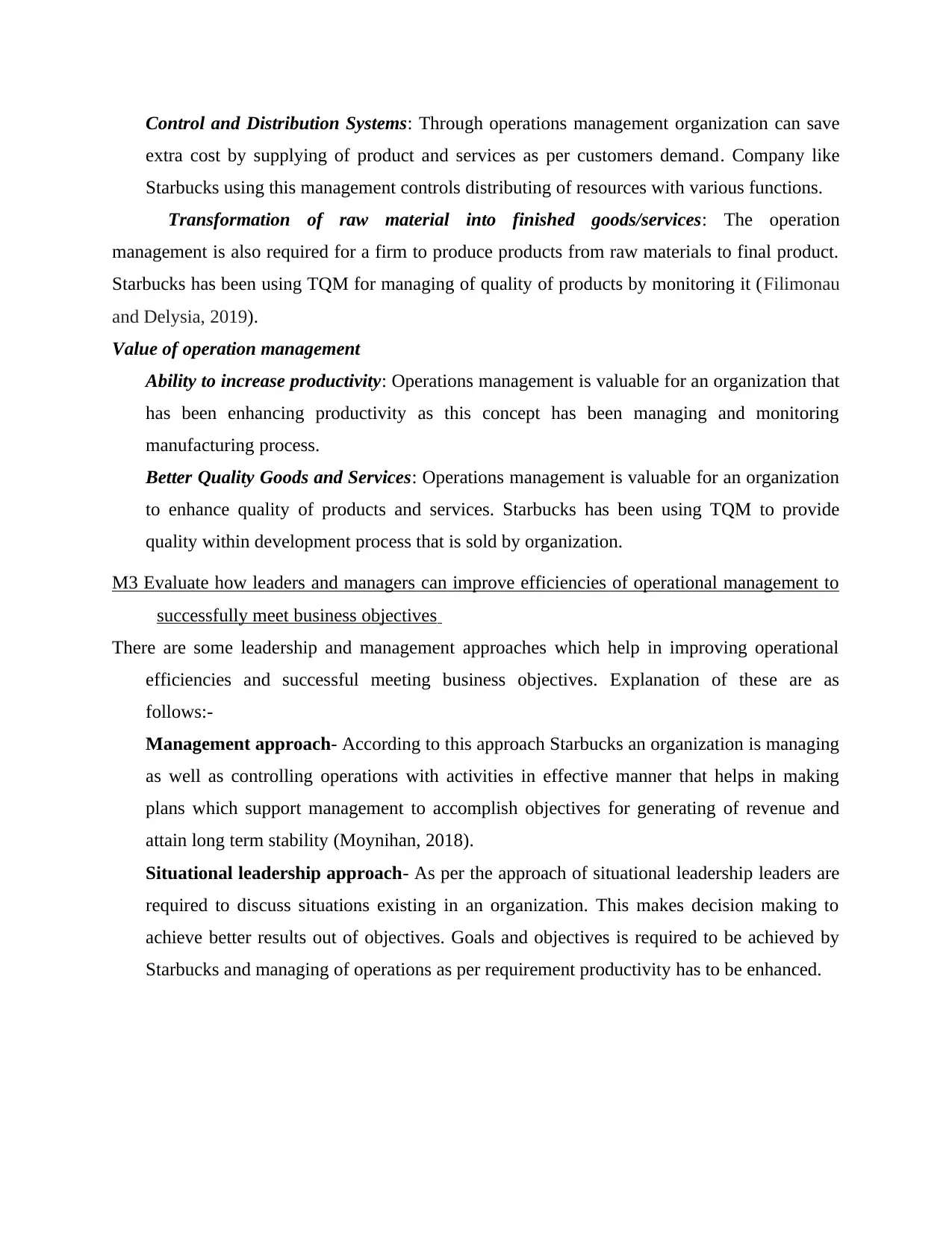
Control and Distribution Systems: Through operations management organization can save
extra cost by supplying of product and services as per customers demand. Company like
Starbucks using this management controls distributing of resources with various functions.
Transformation of raw material into finished goods/services: The operation
management is also required for a firm to produce products from raw materials to final product.
Starbucks has been using TQM for managing of quality of products by monitoring it (Filimonau
and Delysia, 2019).
Value of operation management
Ability to increase productivity: Operations management is valuable for an organization that
has been enhancing productivity as this concept has been managing and monitoring
manufacturing process.
Better Quality Goods and Services: Operations management is valuable for an organization
to enhance quality of products and services. Starbucks has been using TQM to provide
quality within development process that is sold by organization.
M3 Evaluate how leaders and managers can improve efficiencies of operational management to
successfully meet business objectives
There are some leadership and management approaches which help in improving operational
efficiencies and successful meeting business objectives. Explanation of these are as
follows:-
Management approach- According to this approach Starbucks an organization is managing
as well as controlling operations with activities in effective manner that helps in making
plans which support management to accomplish objectives for generating of revenue and
attain long term stability (Moynihan, 2018).
Situational leadership approach- As per the approach of situational leadership leaders are
required to discuss situations existing in an organization. This makes decision making to
achieve better results out of objectives. Goals and objectives is required to be achieved by
Starbucks and managing of operations as per requirement productivity has to be enhanced.
extra cost by supplying of product and services as per customers demand. Company like
Starbucks using this management controls distributing of resources with various functions.
Transformation of raw material into finished goods/services: The operation
management is also required for a firm to produce products from raw materials to final product.
Starbucks has been using TQM for managing of quality of products by monitoring it (Filimonau
and Delysia, 2019).
Value of operation management
Ability to increase productivity: Operations management is valuable for an organization that
has been enhancing productivity as this concept has been managing and monitoring
manufacturing process.
Better Quality Goods and Services: Operations management is valuable for an organization
to enhance quality of products and services. Starbucks has been using TQM to provide
quality within development process that is sold by organization.
M3 Evaluate how leaders and managers can improve efficiencies of operational management to
successfully meet business objectives
There are some leadership and management approaches which help in improving operational
efficiencies and successful meeting business objectives. Explanation of these are as
follows:-
Management approach- According to this approach Starbucks an organization is managing
as well as controlling operations with activities in effective manner that helps in making
plans which support management to accomplish objectives for generating of revenue and
attain long term stability (Moynihan, 2018).
Situational leadership approach- As per the approach of situational leadership leaders are
required to discuss situations existing in an organization. This makes decision making to
achieve better results out of objectives. Goals and objectives is required to be achieved by
Starbucks and managing of operations as per requirement productivity has to be enhanced.

P6 Assess the factors within the business environment that impact upon operational management
and decision-making by leaders and managers
Starbucks can made PESTEL analysis for identifying of opportunities and threads. Internal
and external factors influences organization with productivity. So manager has to build strategies
keeping in mind these factors and they are as follows:
Political factor: -In this tax policies, political stability and government policy has to be
explained. Government policies and changes has to effect organization’s productions level.
Manager need to know about changes and provide stability, policies regarding trade and
government support for industry (de Sousa Jabbour and et. al., 2019).
Economic factor: - This factor has been including development of organization that has
been developing process. Inflation rate, interest rate and economic growth. Managers and
leaders have opportunities over building strategies regarding growth of business.
Social factor: - Organization has opportunity for expansion of business with macho
coffee is very high because huge demand in market analysis manager make decision on
basis of social demand.
Technological factor: - Technological factor has to influence Starbucks in a way that
introduction of e-commerce capability is going to help leaders and managers to take
decision on the basis of it.
Environmental factor: - Mangers of Starbucks as per strategies in respect of changes of
climate and business stability. Organization holds capacity and capability of introducing
eco-friendly products. This makes sustainability of performance to be achieved.
Legal factor: - These factors are related to all kind of rules and regulations that has been
formed under various laws which is required to be followed by an organization. It
influences business of Starbucks in a manner that if laws are not obeyed properly then
legal issues has to be faced by Starbucks.
M4 Analyse how these different factors affect the business environment and wider community
From the discussion it can be seen that important performance of key operations in proper
manner has to be done so that various activities can be performed with affectivity and
accomplish objectives. Success and growth of Starbucks has an important role to be palyed
within an organization. Moreover, by analysing external factors in proper manner useful
decisions will be taken which help in growth of business (Damnjanovic and Røed, 2016).
and decision-making by leaders and managers
Starbucks can made PESTEL analysis for identifying of opportunities and threads. Internal
and external factors influences organization with productivity. So manager has to build strategies
keeping in mind these factors and they are as follows:
Political factor: -In this tax policies, political stability and government policy has to be
explained. Government policies and changes has to effect organization’s productions level.
Manager need to know about changes and provide stability, policies regarding trade and
government support for industry (de Sousa Jabbour and et. al., 2019).
Economic factor: - This factor has been including development of organization that has
been developing process. Inflation rate, interest rate and economic growth. Managers and
leaders have opportunities over building strategies regarding growth of business.
Social factor: - Organization has opportunity for expansion of business with macho
coffee is very high because huge demand in market analysis manager make decision on
basis of social demand.
Technological factor: - Technological factor has to influence Starbucks in a way that
introduction of e-commerce capability is going to help leaders and managers to take
decision on the basis of it.
Environmental factor: - Mangers of Starbucks as per strategies in respect of changes of
climate and business stability. Organization holds capacity and capability of introducing
eco-friendly products. This makes sustainability of performance to be achieved.
Legal factor: - These factors are related to all kind of rules and regulations that has been
formed under various laws which is required to be followed by an organization. It
influences business of Starbucks in a manner that if laws are not obeyed properly then
legal issues has to be faced by Starbucks.
M4 Analyse how these different factors affect the business environment and wider community
From the discussion it can be seen that important performance of key operations in proper
manner has to be done so that various activities can be performed with affectivity and
accomplish objectives. Success and growth of Starbucks has an important role to be palyed
within an organization. Moreover, by analysing external factors in proper manner useful
decisions will be taken which help in growth of business (Damnjanovic and Røed, 2016).
⊘ This is a preview!⊘
Do you want full access?
Subscribe today to unlock all pages.

Trusted by 1+ million students worldwide
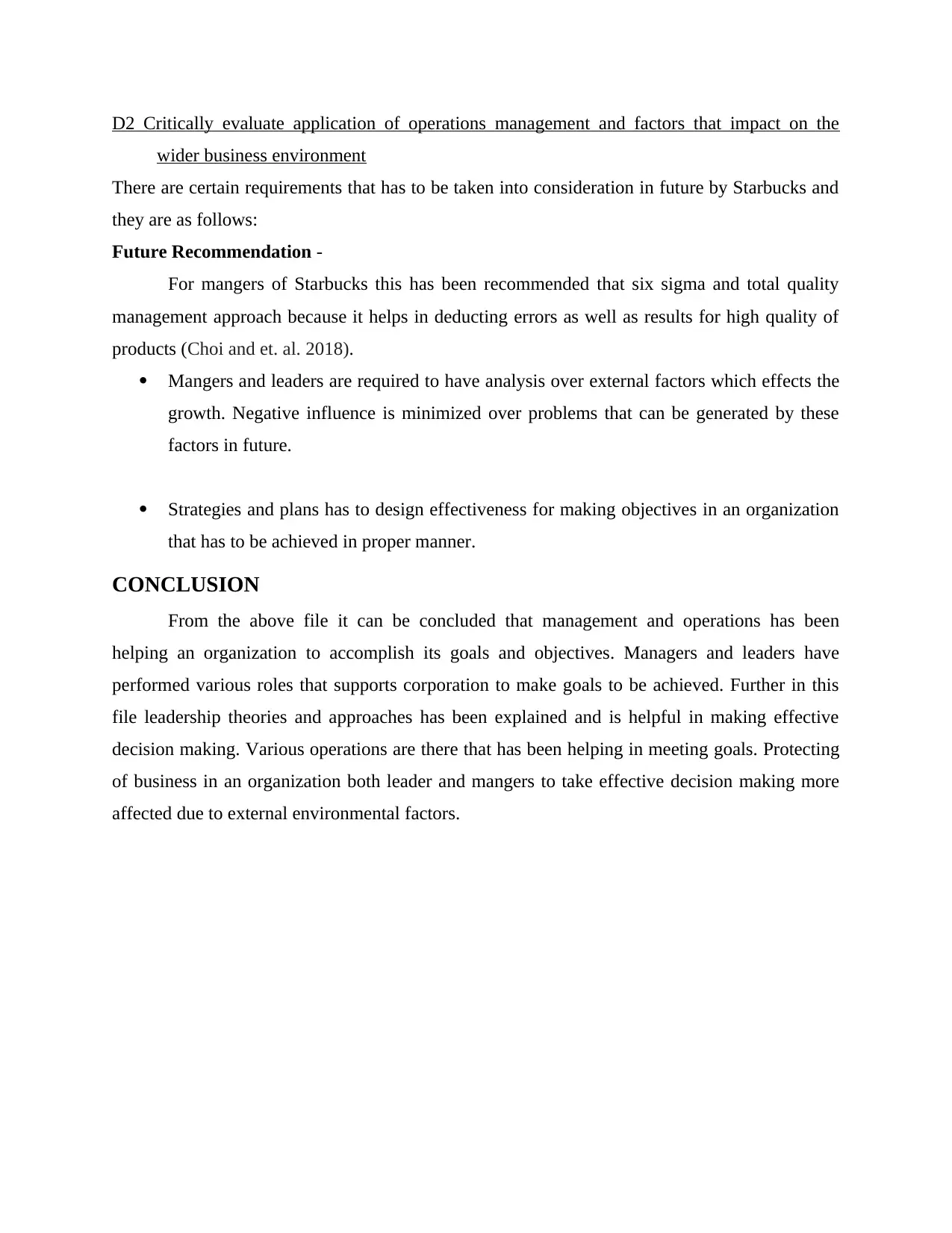
D2 Critically evaluate application of operations management and factors that impact on the
wider business environment
There are certain requirements that has to be taken into consideration in future by Starbucks and
they are as follows:
Future Recommendation -
For mangers of Starbucks this has been recommended that six sigma and total quality
management approach because it helps in deducting errors as well as results for high quality of
products (Choi and et. al. 2018).
Mangers and leaders are required to have analysis over external factors which effects the
growth. Negative influence is minimized over problems that can be generated by these
factors in future.
Strategies and plans has to design effectiveness for making objectives in an organization
that has to be achieved in proper manner.
CONCLUSION
From the above file it can be concluded that management and operations has been
helping an organization to accomplish its goals and objectives. Managers and leaders have
performed various roles that supports corporation to make goals to be achieved. Further in this
file leadership theories and approaches has been explained and is helpful in making effective
decision making. Various operations are there that has been helping in meeting goals. Protecting
of business in an organization both leader and mangers to take effective decision making more
affected due to external environmental factors.
wider business environment
There are certain requirements that has to be taken into consideration in future by Starbucks and
they are as follows:
Future Recommendation -
For mangers of Starbucks this has been recommended that six sigma and total quality
management approach because it helps in deducting errors as well as results for high quality of
products (Choi and et. al. 2018).
Mangers and leaders are required to have analysis over external factors which effects the
growth. Negative influence is minimized over problems that can be generated by these
factors in future.
Strategies and plans has to design effectiveness for making objectives in an organization
that has to be achieved in proper manner.
CONCLUSION
From the above file it can be concluded that management and operations has been
helping an organization to accomplish its goals and objectives. Managers and leaders have
performed various roles that supports corporation to make goals to be achieved. Further in this
file leadership theories and approaches has been explained and is helpful in making effective
decision making. Various operations are there that has been helping in meeting goals. Protecting
of business in an organization both leader and mangers to take effective decision making more
affected due to external environmental factors.
Paraphrase This Document
Need a fresh take? Get an instant paraphrase of this document with our AI Paraphraser
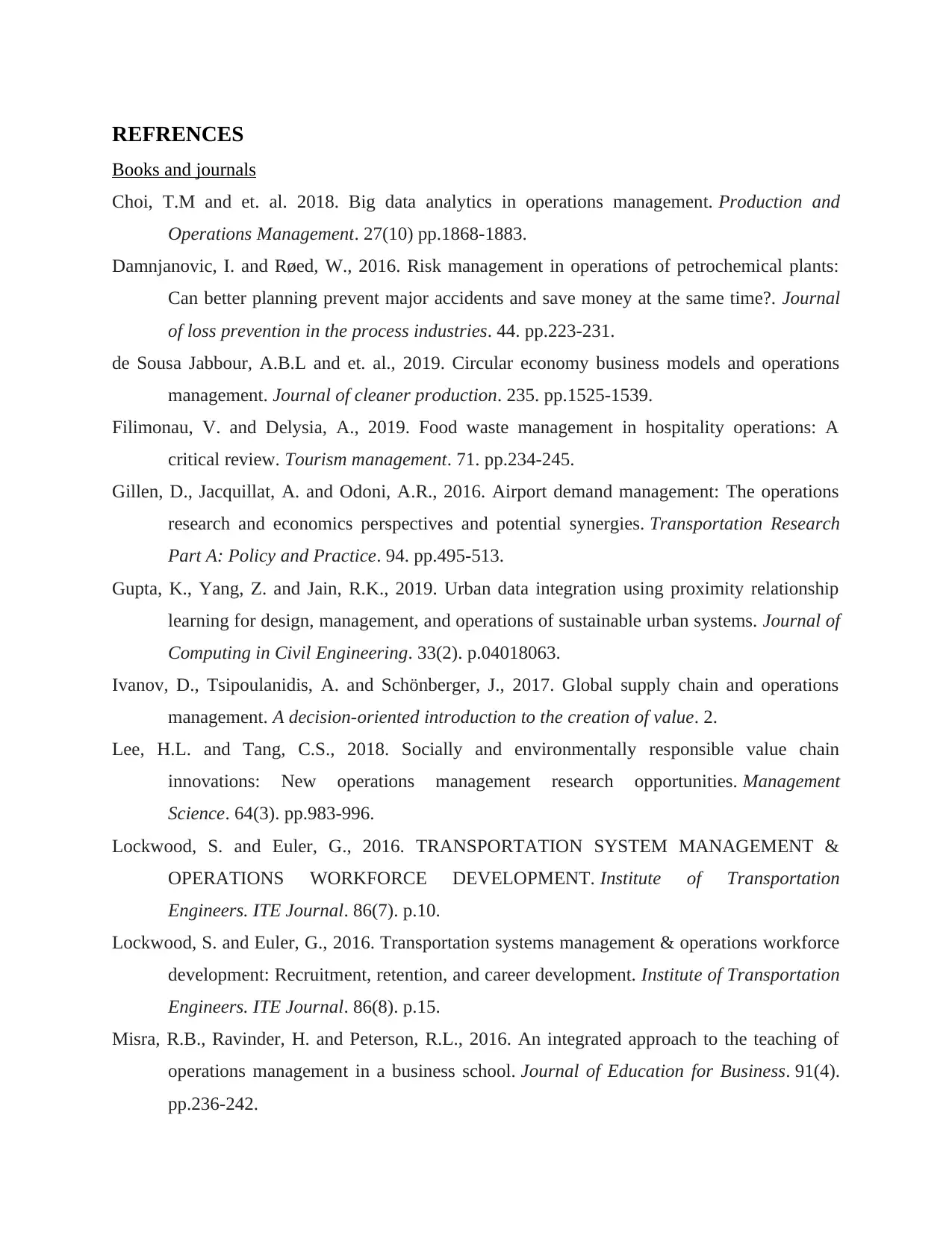
REFRENCES
Books and journals
Choi, T.M and et. al. 2018. Big data analytics in operations management. Production and
Operations Management. 27(10) pp.1868-1883.
Damnjanovic, I. and Røed, W., 2016. Risk management in operations of petrochemical plants:
Can better planning prevent major accidents and save money at the same time?. Journal
of loss prevention in the process industries. 44. pp.223-231.
de Sousa Jabbour, A.B.L and et. al., 2019. Circular economy business models and operations
management. Journal of cleaner production. 235. pp.1525-1539.
Filimonau, V. and Delysia, A., 2019. Food waste management in hospitality operations: A
critical review. Tourism management. 71. pp.234-245.
Gillen, D., Jacquillat, A. and Odoni, A.R., 2016. Airport demand management: The operations
research and economics perspectives and potential synergies. Transportation Research
Part A: Policy and Practice. 94. pp.495-513.
Gupta, K., Yang, Z. and Jain, R.K., 2019. Urban data integration using proximity relationship
learning for design, management, and operations of sustainable urban systems. Journal of
Computing in Civil Engineering. 33(2). p.04018063.
Ivanov, D., Tsipoulanidis, A. and Schönberger, J., 2017. Global supply chain and operations
management. A decision-oriented introduction to the creation of value. 2.
Lee, H.L. and Tang, C.S., 2018. Socially and environmentally responsible value chain
innovations: New operations management research opportunities. Management
Science. 64(3). pp.983-996.
Lockwood, S. and Euler, G., 2016. TRANSPORTATION SYSTEM MANAGEMENT &
OPERATIONS WORKFORCE DEVELOPMENT. Institute of Transportation
Engineers. ITE Journal. 86(7). p.10.
Lockwood, S. and Euler, G., 2016. Transportation systems management & operations workforce
development: Recruitment, retention, and career development. Institute of Transportation
Engineers. ITE Journal. 86(8). p.15.
Misra, R.B., Ravinder, H. and Peterson, R.L., 2016. An integrated approach to the teaching of
operations management in a business school. Journal of Education for Business. 91(4).
pp.236-242.
Books and journals
Choi, T.M and et. al. 2018. Big data analytics in operations management. Production and
Operations Management. 27(10) pp.1868-1883.
Damnjanovic, I. and Røed, W., 2016. Risk management in operations of petrochemical plants:
Can better planning prevent major accidents and save money at the same time?. Journal
of loss prevention in the process industries. 44. pp.223-231.
de Sousa Jabbour, A.B.L and et. al., 2019. Circular economy business models and operations
management. Journal of cleaner production. 235. pp.1525-1539.
Filimonau, V. and Delysia, A., 2019. Food waste management in hospitality operations: A
critical review. Tourism management. 71. pp.234-245.
Gillen, D., Jacquillat, A. and Odoni, A.R., 2016. Airport demand management: The operations
research and economics perspectives and potential synergies. Transportation Research
Part A: Policy and Practice. 94. pp.495-513.
Gupta, K., Yang, Z. and Jain, R.K., 2019. Urban data integration using proximity relationship
learning for design, management, and operations of sustainable urban systems. Journal of
Computing in Civil Engineering. 33(2). p.04018063.
Ivanov, D., Tsipoulanidis, A. and Schönberger, J., 2017. Global supply chain and operations
management. A decision-oriented introduction to the creation of value. 2.
Lee, H.L. and Tang, C.S., 2018. Socially and environmentally responsible value chain
innovations: New operations management research opportunities. Management
Science. 64(3). pp.983-996.
Lockwood, S. and Euler, G., 2016. TRANSPORTATION SYSTEM MANAGEMENT &
OPERATIONS WORKFORCE DEVELOPMENT. Institute of Transportation
Engineers. ITE Journal. 86(7). p.10.
Lockwood, S. and Euler, G., 2016. Transportation systems management & operations workforce
development: Recruitment, retention, and career development. Institute of Transportation
Engineers. ITE Journal. 86(8). p.15.
Misra, R.B., Ravinder, H. and Peterson, R.L., 2016. An integrated approach to the teaching of
operations management in a business school. Journal of Education for Business. 91(4).
pp.236-242.

Ravinder, H. and Kollikkathara, N., 2017. Project Management in Operations Management
Textbooks: Closing the Gap. Journal of the Academy of Business Education. 18.
Roth, A and et. al, 2016. Knowledge creation and dissemination in operations and supply chain
management. Production and Operations Management. 25(9). pp.1473-1488.
Shevchenko, A., Pagell, M., Johnston, D., Veltri, A. and Robson, L., 2018. Joint management
systems for operations and safety: A routine-based perspective. Journal of cleaner
production. 194. pp.635-644.
Ulu, V. and Mulindwa, D., 2016. Legal aspects of hotel chain management and operations. The
Routledge Handbook of Hotel Chain Management. p.346.
Textbooks: Closing the Gap. Journal of the Academy of Business Education. 18.
Roth, A and et. al, 2016. Knowledge creation and dissemination in operations and supply chain
management. Production and Operations Management. 25(9). pp.1473-1488.
Shevchenko, A., Pagell, M., Johnston, D., Veltri, A. and Robson, L., 2018. Joint management
systems for operations and safety: A routine-based perspective. Journal of cleaner
production. 194. pp.635-644.
Ulu, V. and Mulindwa, D., 2016. Legal aspects of hotel chain management and operations. The
Routledge Handbook of Hotel Chain Management. p.346.
⊘ This is a preview!⊘
Do you want full access?
Subscribe today to unlock all pages.

Trusted by 1+ million students worldwide
1 out of 12
Related Documents
Your All-in-One AI-Powered Toolkit for Academic Success.
+13062052269
info@desklib.com
Available 24*7 on WhatsApp / Email
![[object Object]](/_next/static/media/star-bottom.7253800d.svg)
Unlock your academic potential
Copyright © 2020–2025 A2Z Services. All Rights Reserved. Developed and managed by ZUCOL.



